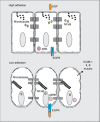Pulmonary epithelial barrier function: some new players and mechanisms
- PMID: 25637609
- PMCID: PMC4747906
- DOI: 10.1152/ajplung.00309.2014
Pulmonary epithelial barrier function: some new players and mechanisms
Abstract
The pulmonary epithelium serves as a barrier to prevent access of the inspired luminal contents to the subepithelium. In addition, the epithelium dictates the initial responses of the lung to both infectious and noninfectious stimuli. One mechanism by which the epithelium does this is by coordinating transport of diffusible molecules across the epithelial barrier, both through the cell and between cells. In this review, we will discuss a few emerging paradigms of permeability changes through altered ion transport and paracellular regulation by which the epithelium gates its response to potentially detrimental luminal stimuli. This review is a summary of talks presented during a symposium in Experimental Biology geared toward novel and less recognized methods of epithelial barrier regulation. First, we will discuss mechanisms of dynamic regulation of cell-cell contacts in the context of repetitive exposure to inhaled infectious and noninfectious insults. In the second section, we will briefly discuss mechanisms of transcellular ion homeostasis specifically focused on the role of claudins and paracellular ion-channel regulation in chronic barrier dysfunction. In the next section, we will address transcellular ion transport and highlight the role of Trek-1 in epithelial responses to lung injury. In the final section, we will outline the role of epithelial growth receptor in barrier regulation in baseline, acute lung injury, and airway disease. We will then end with a summary of mechanisms of epithelial control as well as discuss emerging paradigms of the epithelium role in shifting between a structural element that maintains tight cell-cell adhesion to a cell that initiates and participates in immune responses.
Keywords: epithelial barrier; ions; lung; permeability; transport.
Copyright © 2015 the American Physiological Society.
Figures



Similar articles
-
Interrelations/cross talk between transcellular transport function and paracellular tight junctional properties in lung epithelial and endothelial barriers.Am J Physiol Lung Cell Mol Physiol. 2007 Sep;293(3):L520-4. doi: 10.1152/ajplung.00218.2007. Epub 2007 Jun 29. Am J Physiol Lung Cell Mol Physiol. 2007. PMID: 17601795
-
Claudins and alveolar epithelial barrier function in the lung.Ann N Y Acad Sci. 2012 Jun;1257:175-83. doi: 10.1111/j.1749-6632.2012.06533.x. Ann N Y Acad Sci. 2012. PMID: 22671604 Free PMC article. Review.
-
Paracellular barrier and channel functions of TJ claudins in organizing biological systems: advances in the field of barriology revealed in knockout mice.Semin Cell Dev Biol. 2014 Dec;36:177-85. doi: 10.1016/j.semcdb.2014.09.019. Epub 2014 Oct 12. Semin Cell Dev Biol. 2014. PMID: 25305579 Review.
-
[Claudins as tight junction proteins: the molecular element of paracellular transport].Ross Fiziol Zh Im I M Sechenova. 2013 Feb;99(2):175-95. Ross Fiziol Zh Im I M Sechenova. 2013. PMID: 23650732 Review. Russian.
-
Airway Epithelial Barrier Dysfunction in Chronic Obstructive Pulmonary Disease: Role of Cigarette Smoke Exposure.Am J Respir Cell Mol Biol. 2018 Feb;58(2):157-169. doi: 10.1165/rcmb.2017-0200TR. Am J Respir Cell Mol Biol. 2018. PMID: 28933915 Review.
Cited by
-
Alpha-1 antitrypsin limits neutrophil extracellular trap disruption of airway epithelial barrier function.Front Immunol. 2023 Jan 10;13:1023553. doi: 10.3389/fimmu.2022.1023553. eCollection 2022. Front Immunol. 2023. PMID: 36703990 Free PMC article.
-
The Protective Effects of a Synthetic Geranyl Acetophenone in a Cellular Model of TNF-α-Induced Pulmonary Epithelial Barrier Dysfunction.Molecules. 2018 Jun 5;23(6):1355. doi: 10.3390/molecules23061355. Molecules. 2018. PMID: 29874809 Free PMC article.
-
Advanced approaches to overcome biological barriers in respiratory and systemic routes of administration for enhanced nucleic acid delivery to the lung.Expert Opin Drug Deliv. 2023 Jul-Dec;20(11):1531-1552. doi: 10.1080/17425247.2023.2282535. Epub 2023 Dec 20. Expert Opin Drug Deliv. 2023. PMID: 37946533 Free PMC article. Review.
-
Azithromycin ameliorates sulfur dioxide-induced airway epithelial damage and inflammatory responses.Respir Res. 2020 Sep 10;21(1):233. doi: 10.1186/s12931-020-01489-8. Respir Res. 2020. PMID: 32912304 Free PMC article.
-
Aging-Associated Molecular Changes in Human Alveolar Type I Cells.J Respir Biol Transl Med. 2024 Sep;1(3):10012. doi: 10.35534/jrbtm.2024.10012. Epub 2024 Jul 22. J Respir Biol Transl Med. 2024. PMID: 39220636 Free PMC article.
References
-
- Ablimit A, Hasan B, Lu W, Qin W, Wushouer Q, Zhong N, Upur H. Changes in water channel aquaporin 1 and aquaporin 5 in the small airways and the alveoli in a rat asthma model. Micron 45: 68–73, 2013. - PubMed
-
- Adir Y, Welch LC, Dumasius V, Factor P, Sznajder JI, Ridge KM. Overexpression of the Na-K-ATPase α2-subunit improves lung liquid clearance during ventilation-induced lung injury. Am J Physiol Lung Cell Mol Physiol 294: L1233–L1237, 2008. - PubMed
-
- Al-Bazzaz FJ, Hafez N, Tyagi S, Gailey CA, Toofanfard M, Alrefai WA, Nazir TM, Ramaswamy K, Dudeja PK. Detection of Cl-HCO3- and Na+-H+ exchangers in human airways epithelium. JOP 2: 285–290, 2001. - PubMed
Publication types
MeSH terms
Grants and funding
LinkOut - more resources
Full Text Sources
Other Literature Sources

